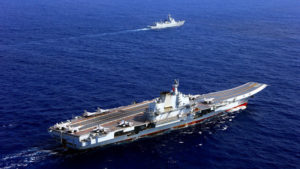
The aircraft carrier Liaoning (Hull 16) steams in the western Pacific. The aircraft carrier Liaoning (Hull 16), several guided-missile destroyers, frigates and dozens of aircraft attached to the Navy of the Chinese People’s Liberation Army took part in a combat exercise at an unidentified area east of the Bashi Channel in the western Pacific on Apr. 20. The exercise was a routine arrangement as a part of the PLA Navy’s annual training plan. (eng.chinamil.com.cn / Photo by Zhang Lei)
China is slowly building new bases in strategic locations around the Indian Ocean and expanding elsewhere, especially in Africa. In Foreign Policy, Eric A. Miller suggests Africa will be the destination of even more new Chinese bases, and that it’s only a question of when not if, these expansions take place. Miller writes:
This leads us to what China is least likely to emphasize: All African countries have a right to participate in discussions about the future militarization of their regions. This is especially true because that militarization could have long-term consequences that threaten natural resource and strategic mineral extraction vital to Africa’s economic future. For instance, Chinese illegal, unreported, and unregulated (IUU) fishing practices impose considerable financial and human costs on West Africans themselves. According to one leading Western academic, more than 60 percent of China’s estimated total distant-water catch, worth $5 billion, takes place in West Africa. West African countries also disproportionately rely on fish for 60 to 80 percent of their animal protein intake, so these Chinese practices are threatening West Africans’ day-to-day lives. This demonstrates China’s willingness to harm local economies for its own gain. A Chinese military presence in West Africa could easily support China’s nefarious IUU practices, which presumably would be unwelcome to West African countries.
When we look at West Africa, Equatorial Guinea has garnered the most attention of late and for good reason. Much as in Cambodia, Chinese markets are central to the Equatoguinean economy. China is Cambodia’s leading importer, taking in 27 percent of Cambodia’s total exports. Similarly, China is the leading destination for Equatoguinean exports, accounting for 34 percent. Moreover, in recent years, Equatorial Guinea’s debt to China was an estimated 49.7 percent of GDP, a staggering figure that stems from billions of dollars of loans used for local infrastructure projects. Beijing and Malabo also have a 50-year diplomatic relationship, and Equatorial Guinea was the first African country to receive Chinese vaccines during the COVID-19 pandemic. Economic ties make a powerful incentive—and lever—for additional cooperation. Just ask Sri Lanka about leverage: In December 2017, Chinese firms were able to take control of Hambantota Port on a 99-year lease after the country was unable to cover growing debt linked to the port.
Equatorial Guinea could offer the Chinese a lot and, most importantly, something the PLA does not have in Djibouti—access to the Atlantic Ocean and airfields for fixed-wing aircraft. As the then-head of U.S. Africa Command, Gen. Stephen Townsend, noted in testimony to Congress this spring, a base in the Atlantic would put the Chinese military “several thousand miles closer to the U.S. homeland.” The country also has three airfields capable of supporting heavy-lift cargo aircraft, one of which is located near the Port of Bata. If the ability to protect Chinese citizens and interests abroad is integral to Beijing’s strategy—as it has communicated—finding ways to use air infrastructure is essential to future evacuations.
Moreover, deep-water ports exist in Bata and Malabo that Beijing could easily upgrade for military purposes, especially because it is quite familiar with these facilities. In 2006, the Export-Import Bank of China funded the initial construction of the Port of Bata, which the state-owned China Communications Construction Co.’s First Harbor Engineering Co. built in 2014. The China Road and Bridge Corp., another state-owned enterprise, made significant upgrades to the port.
So considering the implications of Chinese basing for African countries, what is next? Analysts should watch for indicators of basing progress, including upticks in bilateral military engagements and military deployments to the region, forward staging of construction material, increased volume of transport from military or commercial flights or ships, improved or new security perimeters at base locations, trial balloons in Chinese media, less official outlets like the Global Times socializing the idea in regional media, and government statements. The actual construction of new or improved naval, air, ground, or logistics facilities would of course be the most compelling sign.
If you’re willing to fight for Main Street America, click here to sign up for the Richardcyoung.com free weekly email.





